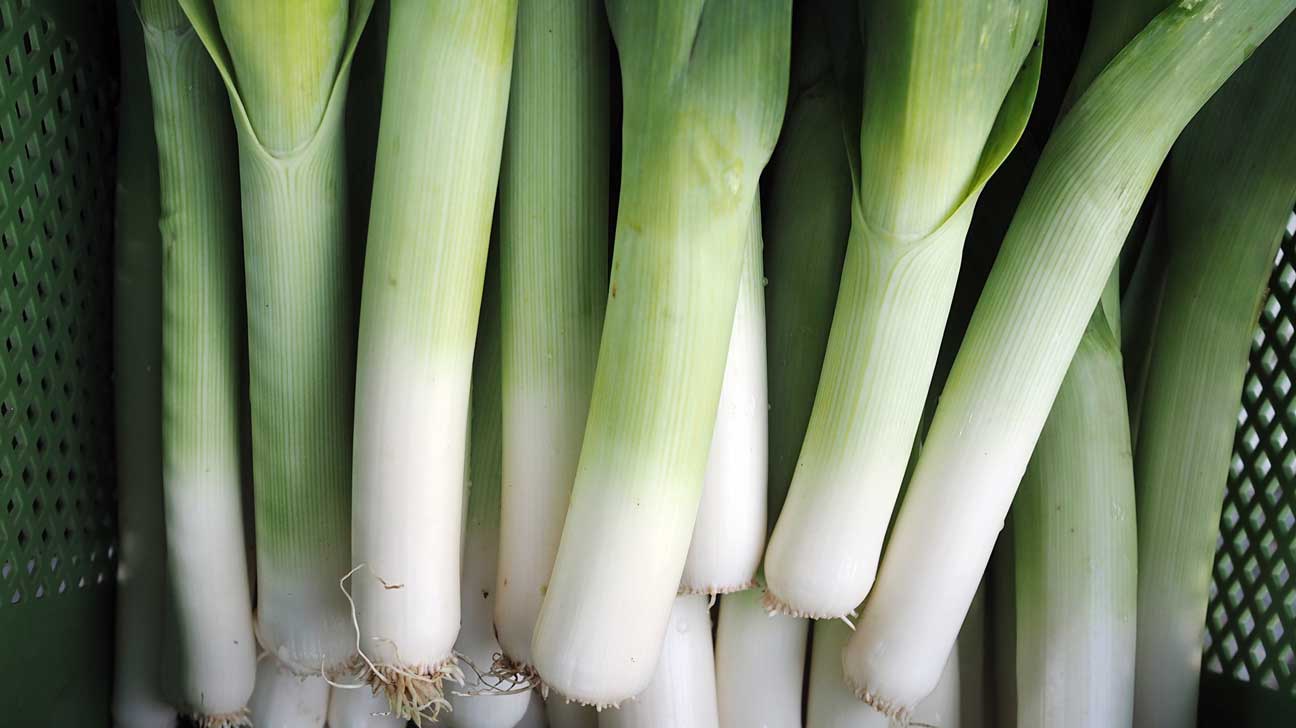Leeks and green onions may look strikingly similar, but don’t be fooled by their appearances!
These members of the allium family have some distinct differences that set them apart.
From their taste and texture to their culinary uses, leeks and green onions each bring their own unique flavor to the kitchen.
Whether you’re a seasoned chef or just starting your culinary journey, join us as we explore the world of leeks and green onions, unraveling the mysteries and discovering the secrets behind these two amazing ingredients.
leek vs green onion
Leeks and green onions are both members of the allium family and have similar appearances.
However, there are notable differences between the two.
Leeks have a milder flavor compared to green onions and have a delicate texture when cooked, whereas green onions maintain their sharpness.
Only the white and light green parts of leeks are typically consumed, while the entire green onion, including the white bulbs and green parts, is edible.
Leeks are larger and sold in single stalks, while green onions are smaller and slender.
In terms of culinary use, leeks can be braised, used in soups, stews, quiches, or dumplings, and can also be used raw or fried as a garnish when thinly sliced.
Green onions are commonly used as a garnish in dishes like ramen, stir-fries, pastas, fried rice, or salads, and can be used cooked or raw.
While leeks and green onions can be substituted for each other, more green onions are needed to replace leeks, and when substituting leeks for green onions, they should be cooked longer and sliced thinly.
Key Points:
- Leeks and green onions are both members of the allium family and have similar appearances.
- Leeks have a milder flavor and delicate texture when cooked, while green onions maintain their sharpness.
- Only the white and light green parts of leeks are consumed, while the entire green onion is edible.
- Leeks are larger and sold in single stalks, while green onions are smaller and slender.
- Leeks can be braised, used in soups, stews, quiches, or dumplings, and can also be used raw or fried as a garnish when thinly sliced.
- Green onions are commonly used as a garnish in dishes like ramen, stir-fries, pastas, fried rice, or salads, and can be used cooked or raw.
leek vs green onion – Watch Video


Pro Tips:
1. Did you know that leeks and green onions are actually members of the same plant family, Allium? They both belong to the onion genus, but have distinct appearances and flavors.
2. The ancient Romans were quite fond of leeks and believed that consuming them would improve their singing abilities. As a result, they often ate leeks before performances in amphitheaters.
3. The green onion, also known as scallion or spring onion, has been used in Chinese medicine for centuries. It is believed to have properties that help cool the body, detoxify, and improve digestion.
4. Leeks have a fascinating history and were highly regarded in ancient Egypt. They were even utilized in the mummification process, as their strong aroma was thought to ward off evil spirits and protect the deceased.
5. Green onions are extremely versatile and can be easily regrown from their scraps. By placing the root end in water or soil, new shoots will emerge, making it a unique and sustainable way to enjoy fresh green onions at home.
Appearance And Family: Leeks And Green Onions Similarities
Leeks and green onions, although distinct in their own ways, share several similarities. Both of these vegetables belong to the allium family, which includes other members like garlic, chives, and shallots.
One common characteristic between leeks and green onions is their similar appearance. They both feature long, cylindrical stalks and vibrant green leaves, making them visually appealing additions to any dish.
However, upon closer inspection, some subtle differences become apparent.
- Leeks, with their elongated shape, have a larger diameter and can grow significantly taller than green onions.
- On the other hand, green onions are more slender, with a smaller diameter and a shorter length.
These differences in size and shape can affect various aspects of their culinary uses, as we will explore further in this article.
Flavor Comparison: Leeks Are Milder Than Green Onions
When it comes to flavor, leeks and green onions differ in intensity. Leeks have a milder and sweeter taste compared to green onions, which possess a sharper and stronger onion flavor. This distinction in flavor profile makes leeks a versatile ingredient that can complement a wide range of dishes. The mildness of leeks allows for them to add subtle onion notes without overpowering the other flavors in a recipe.
In contrast, green onions provide a bolder and more pronounced onion taste, perfect for adding a burst of flavor to any dish. Their sharpness can enhance the overall taste and provide a distinct oniony kick. However, it is important to consider the desired flavor profile when deciding between leeks and green onions.
- Leeks have a milder and sweeter taste.
- Green onions possess a sharper and stronger onion flavor.
Texture When Cooked: Delicate Leeks Vs Sharp Green Onions
Another notable contrast between leeks and green onions is their texture when cooked.
-
Leeks tend to have a delicate and tender texture after cooking. They soften and become almost silky, providing a melt-in-your-mouth experience. This texture makes leeks an excellent choice for dishes that require a smooth and silky consistency, such as creamy soups, quiches, or dumplings.
-
On the other hand, even when cooked, green onions maintain their sharpness and retain some of their crunchiness. Their texture adds a pleasant contrast to dishes, making them a popular choice as a garnish or inclusion in stir-fries, fried rice, or salads. The ability of green onions to maintain their texture after cooking makes them suitable for dishes that benefit from a slight crunch.
Edible Parts: Consuming The White And Light Green Parts Of Leeks
When it comes to consuming leeks, only the white and light green parts are typically used. The dark green tops of leeks are tough and fibrous, making them less desirable for consumption. However, the white and light green portions are tender and packed with flavor, making them the preferred choice for cooking. It is important to properly clean leeks before use, as dirt and grit may hide between their layers.
In contrast, green onions are entirely edible from the white bulbs to the green parts. Each part of the green onion offers a slightly different flavor profile, with the white bulbs being the most intense and the green tops providing a milder taste. The versatility of being able to use all parts of green onions makes them a convenient choice in the kitchen.
- Leeks: only the white and light green parts are used.
- Green onions: all parts, from white to green, are edible.
- Leeks need proper cleaning before use to remove dirt and grit.
Whole Edibility: Green Onions Are Entirely Edible
Green onions are entirely edible, including both the white bulbs and the green tops. This aspect of green onions makes them an attractive choice in the kitchen, as there is no waste involved when preparing these vegetables. Whether you choose to use the white bulbs for a stronger onion flavor or the green tops for a milder taste, you can incorporate the entire vegetable into your dishes. This total edibility adds to the convenience and versatility of green onions in cooking.
Size And Shape: Leeks Are Larger And Sold In Single Stalks, While Green Onions Are Smaller And Slender
One visual difference between leeks and green onions is their size and shape.
Leeks are generally larger and are typically sold in single stalks. Their elongated shape and larger diameter contribute to their distinct appearance when compared to green onions.
Green onions, on the other hand, are smaller and more slender in size. They are often bundled together, with multiple green onions in one pack. The smaller size and uniformity of green onions make them easier to handle and prepare in the kitchen.
Culinary Uses Of Leeks: Braising, Soups, Stews, Quiches, And More
Leeks have a wide range of culinary uses and can be incorporated into various dishes. One popular method of cooking leeks is braising. Braised leeks become incredibly tender and develop a sweet, mellow flavor. They can be enjoyed as a side dish or used as a flavorful bed for roasted meats or fish.
Leeks are also a common ingredient in soups and stews. Their mild flavor adds depth and complexity to the overall dish. Whether in a comforting potato leek soup or a hearty beef stew, the delicate taste of leeks shines through.
Additionally, leeks can be used as a filling in quiches or dumplings, providing a unique flavor profile that pairs well with other ingredients. Raw or fried, thinly sliced leeks can be used as a garnish to add a touch of elegance and flavor to a variety of dishes.
Culinary Uses Of Green Onions: Garnish In Various Dishes, Cooked Or Raw
Green onions are a versatile ingredient widely used as a garnish in various dishes. With their distinct onion flavor and texture, they add a vibrant and fresh touch to meals. Here are some ways green onions can elevate your dishes:
-
Sprinkled on top: Green onions are commonly sprinkled on top of dishes like ramen, stir-fries, pastas, fried rice, or salads. Their sharpness enhances the appearance and taste of these dishes.
-
Cooked or raw: Green onions can be used either cooked or raw, depending on the desired outcome. Cooking green onions can mellow out their sharp flavor and bring out a subtle sweetness. Raw green onions, on the other hand, provide a strong punch of onion flavor, making them an excellent choice for brightening up salads or adding an extra layer of freshness to dishes.
Remember, green onions can be a versatile addition to your culinary creations, enhancing both the flavor and visual appeal. Experiment with different cooking techniques to discover their full potential.
Substitutability: Leeks And Green Onions Can Be Substituted, With Adjusted Quantities
Leeks and green onions can be substituted for each other in certain recipes, with a few considerations. When substituting leeks for green onions, it is important to note that leeks have a milder flavor. Therefore, you may need to use more green onions to achieve a comparable taste. The size difference should also be taken into account, as leeks are larger and green onions are smaller.
Similarly, when substituting green onions for leeks, keep in mind that green onions have a sharper flavor. Adjustments may be required to balance the overall taste of a dish. Additionally, since green onions are smaller, they will cook faster than leeks, so the cooking time should be adjusted accordingly.
- Leeks can be substituted for green onions, but more green onions are needed for a similar taste.
- Green onions can be used instead of leeks, but adjustments may be necessary to balance the flavor.
- Leeks are larger in size, while green onions are smaller in size.
- Green onions cook faster than leeks, so the cooking time should be adjusted when using them.
“When substituting leeks for green onions, keep in mind that leeks have a milder flavor. Therefore, you may need to use more green onions to achieve a comparable taste.”
Cooking Considerations: Longer Cook Time And Thin Slicing For Leeks When Substituting For Green Onions
When using leeks as a substitute for green onions, it is essential to acknowledge the differences in texture and cooking time. Leeks take longer to cook than green onions because of their denser structure. To ensure that the leeks reach the desired tenderness, they should be cooked for a longer time.
Furthermore, when substituting leeks for green onions, it is recommended to slice the leeks thinly. This allows the leeks to cook more evenly and accelerates the softening process. Thinly sliced leeks also provide a more comparable texture to green onions in dishes where a slight crunch is desired.
Both leeks and green onions offer unique flavors and textures that can enhance a variety of dishes. While leeks are milder and have a delicate texture when cooked, green onions provide a sharper taste and maintain their sharpness even after cooking. Understanding the similarities and differences between these two allium vegetables allows for informed choices in the kitchen. Whether you choose leeks or green onions, both vegetables provide nutritional benefits that contribute to a wholesome diet.

You may need to know these questions about leek vs green onion
Are leeks and green onions the same thing?
No, leeks and green onions are not the same thing. Although they belong to the same genus, they are different species. Leeks are part of the Allium ampeloprasum species, while green onions are from the Allium cepa species. While they may share some similarities in appearance and taste, their genetic makeup and cultural usage set them apart. Leeks are known for their mild onion flavor and are commonly used in soups and stews, while green onions are often used as a garnish or in stir-fries for their more pronounced onion taste.
What is the taste difference between leeks and onions?
Unlike onions, leeks possess a distinct, delicate flavor profile. While onions often bring a bold and pungent taste to dishes, leeks offer a milder and sweeter taste, which makes them a preferred option when seeking a more subtle onion flavor. When raw, leeks boast a crisp and crunchy texture, but transform into a soft and buttery consistency when cooked.
Do leeks and onions taste similar?
While both leeks and onions belong to the same family of vegetables, the Allium family, their tastes do share some similarities. Leeks have a milder flavor compared to onions, but they still possess a subtle onion-like taste. However, leeks tend to be sweeter and have a less intense flavor than onions. The taste of leeks can also vary depending on the cooking method, making them a versatile ingredient in various dishes.
Do leeks and scallions taste different?
Yes, leeks and scallions do have distinct tastes. While they belong to the same onion family, leeks have a larger size and a milder onion-like flavor compared to scallions. Leeks also possess a subtle hint of garlic flavor, which becomes more pronounced when raw. However, when cooked, this garlicky taste becomes more subdued.
Reference source
https://www.allrecipes.com/leeks-vs-green-onions-how-are-they-different-7508276
https://www.masterclass.com/articles/leeks-vs-green-onions
https://www.savorysuitcase.com/leek-vs-green-onion/
https://northernyum.com/blog/what-do-leeks-taste-like/



